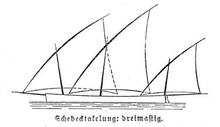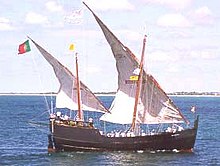Latin rigging
The Latin rigging was the predominant rigging for ships in the Mediterranean from the early Middle Ages (6th century AD) until the Age of Discovery (see also: Latin sails ). Starting from smaller and coastal vessels of the Romans , it developed over the ship type of the galeas to the chebec , which represents the coronation and end point of this type of rig. The Portuguese caravels that heralded the Age of Discovery in the 15th century were rigged in Latin. The latin rigging made it possible for the first time to sail against the wind with an appropriately shaped keel. In terms of maneuverability, these ships were superior to the pure square sailers of the Northern Europeans. One disadvantage was the enormously long spars that had to be taken around the mast at every turn to the rear and at every jibe forwards. This required a very large number of crews, and if the wind was too strong, the sail had to be completely lowered for every tack.
The gaff sail can be seen as a further development of the Latin rigging.
Individual evidence
- ↑ Castro, F .; Fonseca, N .; Vacas, T .; Ciciliot, F. (2008): "A Quantitative Look at Mediterranean Lateen- and Square-Rigged Ships (Part 1)", in: The International Journal of Nautical Archeology , Vol. 37, No. 2, pp. 347-359 ( 1-2); Whitewright, Julian (2009): “The Mediterranean Lateen Sail in Late Antiquity”, in: The International Journal of Nautical Archeology , Vol. 38, No. 1, pp. 97-104
- ^ Casson, Lionel (1995): "Ships and Seamanship in the Ancient World," Johns Hopkins University Press, ISBN 978-0-8018-5130-8 , pp. 243-245
Web links
- Campbell, IC (1995): "The Lateen Sail in World History" (PDF; 192 kB), in: Journal of World History , Vol. 6, No. 1, pp. 1–23

